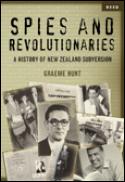Graeme Hunt's Book on New Zealand Spies and Revolutionaries – Chapter Six: The empire strikes back
Scoop is serializing the first 1000 words of each chapter of author Graeme Hunt's latest book: Spies And Revolutionaries – A History of New Zealand Subversion. Click here for Chapter Six: The empire strikes back
 The history of New Zealand's intelligence agencies and
those it has spied on have been laid bare in a book by
Auckland-based journalist, author, and historian Graeme
Hunt.
The history of New Zealand's intelligence agencies and
those it has spied on have been laid bare in a book by
Auckland-based journalist, author, and historian Graeme
Hunt.
Spies And Revolutionaries – A History of New Zealand Subversion details how several prominent New Zealanders, all of whom are dead, spied for the former Soviet Union during the Cold War. Accusations and suspicions are laid bare before files and information that has never before been made public. This book will clearly recharge debate as to whether Dr Bill Sutch, diplomat Paddy Costello, and public servant Ian Milner were spies acting against New Zealand's national interest.
CHAPTER SIX: The empire strikes back
 The Labour Party victory in the November 1935 general
election brought to power several former Red Feds and even
some former Bolsheviks but it did nothing for the Communist
Party, which was still beyond the political pale. The
improving economy, which would have greeted any incoming
government, and Labour’s bold industrialisation, health
and welfare programmes, relegated ‘street’ radicalism to
the back yard. New Zealand had a radical government with a
thumping mandate, committed to creating a better society out
of the ruins of the Depression. There was little room for a
group of unelected communists offering the same thing,
except among some trade unions.
The Labour Party victory in the November 1935 general
election brought to power several former Red Feds and even
some former Bolsheviks but it did nothing for the Communist
Party, which was still beyond the political pale. The
improving economy, which would have greeted any incoming
government, and Labour’s bold industrialisation, health
and welfare programmes, relegated ‘street’ radicalism to
the back yard. New Zealand had a radical government with a
thumping mandate, committed to creating a better society out
of the ruins of the Depression. There was little room for a
group of unelected communists offering the same thing,
except among some trade unions.
The effect of the election landslide was two-fold: the Communist Party appeared less of a threat to the established order and Labour, while no friend of the party, worried less about it. Prosecutions for sedition and inciting violence and lawlessness, which had peaked in 1932, dropped away sharply. The new minister in charge of the police force, Peter Fraser, even ordered the return of books seized from communist Dick Griffin during raids in 1931.
This relaxed state of affairs changed with the signing of the Soviet–German Non-Aggression Pact on 23 August 1939 and with the outbreak of war a few days later. Initially, the Communist Party of New Zealand had backed the principle of war against Nazism, supporting, albeit reluctantly, Britain’s commitment to preserve Polish independence. This continued for a few weeks after the dismemberment of Poland by the forces of the Soviet Union and Germany. By October the attitude of New Zealand communists had changed and by December, by which time Soviet forces had invaded Finland, they were describing the conflict as an ‘imperialist war waged by the capitalist classes of Germany, Britain and France for trade, markets and colonies’.
The Communist Party of New Zealand, like other communist parties in the West, became a virtual enemy within the state. Many Marxists outside the party, including those in the powerful Federated Seamen’s Union, had already shifted their allegiance to the exiled Leon Trotsky in Mexico in protest at Stalin’s dictatorship.1 The Soviet Union’s naked aggression in 1939 simply confirmed that they had made the right decision.
The New Zealand authorities had no choice but to act. They had to make the dominion as safe from communists as from Nazi sympathisers and most of the new enemies of the state were in the former camp. Security intelligence work by the police force, which had fallen away from the mid-1930s, became a priority once more. But the armed forces’ chiefs were not convinced that a police security intelligence service was appropriate in wartime and called for the establishment of an intelligence bureau independent of the police that would serve civilian and military security needs. They had agreed in 1938 to set up combined intelligence centres in the event of war and when hostilities broke out these centres liaised with the police force’s tiny security intelligence operation –– principally a team of five detectives headed by Detective Sergeant Jim Nalder in Auckland. The government, meanwhile, went into wartime mode, doing the things its members savaged an earlier generation of politicians for in World War I.
Fraser became prime minister in April 1940 after the death of Michael Savage and moved swiftly to clamp down on subversives and fifth columnists in the way the Massey government had clamped down on him and fellow anti-conscriptionists during World War I. Emergency regulations2 had been introduced in September 1939, two days before war was declared, giving police the powers to suppress subversive publications and act against those publicly opposing the war effort. But the police force found the regulations ‘administratively deficient’, according to historian Graeme Dunstall.3
One of the first to challenge the new order was the charismatic Ormond Burton, a 46-year-old Methodist minister who was a decorated veteran from World War I and the leading Christian pacifist of his day. He was arrested with two others outside Parliament the day after war was declared for speaking against New Zealand’s participation in the conflict. He was convicted under the new regulations but continued over the next few months to campaign publicly against the war, despite a plea by Fraser to be silent, and being fined for breaching the regulations. In June 1940 he was arrested again, this time for speaking without a permit, and jailed for 12 months.
By then, Denmark, Norway, Belgium and Holland had fallen to the Germans, and France was on the verge of collapse. The Baltic states of Lithuania, Latvia and Estonia, largely forgotten in the conflict, would soon be under Russian control. Not surprisingly, New Zealanders had become far less tolerant of dissidents than at the start of the war. The Methodist Church of New Zealand, embarrassed by Burton’s blatant partisanship, expelled him at its 1942 conference4 but this failed to curb his outspoken commitment to pacifism. He was convicted that year of editing, publishing and attempting to publish a subversive document (the bulletin of the Christian Pacifist Society of New Zealand, an organisation he had co-founded in 1938) and jailed for two and a half years. He rejected an offer of freedom from the judge in return for refraining from writing or speaking on pacifism and served his full term, less 11 months for good behaviour.
The irony of Burton’s plight was that he had served his country in World War I when Fraser, Bob Semple and other future members of the first Labour government were in jail for opposing conscription or the war. Burton converted to Christian pacifism in the early 1920s out of disgust and horror at the failure of World War I to bring about genuine peace and reconciliation. Fraser’s view was the reverse –– World War I had been an imperialist conflict at the expense of the workers and not worthy of support, whereas World War II had been started by fascists intent on destroying workers’ rights. All round, in Fraser’s view, World War II had a higher calling. But he could not mask entirely the smell of hypocrisy, especially after conscription was reintroduced in June 1940. (Semple, the minister of national service, drew the first ball of Labour’s first conscription ballot.)
Hypocrisy aside, Burton was treated with kid gloves compared with communist lawbreakers. The communist newspaper, the People’s Voice, was fined in April 1940 for campaigning against the ‘imperialist war’, shut down and its presses seized the following month under even tougher emergency regulations.5 The left-wing journal, Tomorrow, which had published John A. Lee’s savage attack on the dying Savage in 1939, was closed three weeks later.
See Also:
Scoop is serializing the first 1000 words of each chapter of author Graeme Hunt's latest book: Spies And Revolutionaries – A History of New Zealand Subversion.
SRP: $29.99
ISBN:
9780790011400
340p, includes index, black and white
photos
Reed Publishing (NZ) Ltd www.reed.co.nz
Release: August 6 2007
For more, see… Reed Publishers, Spies And
Revolutionaries



 Eugene Doyle: The Fall Of Saigon 1975 - Fifty Years Of Repeating What Was Forgotten
Eugene Doyle: The Fall Of Saigon 1975 - Fifty Years Of Repeating What Was Forgotten Peter Dunne: Dunne's Weekly - Trump's Tariffs Still Pose Risks For New Zealand
Peter Dunne: Dunne's Weekly - Trump's Tariffs Still Pose Risks For New Zealand Keith Rankin: Barbecued Hamburgers And Churchill's Bestie
Keith Rankin: Barbecued Hamburgers And Churchill's Bestie Gordon Campbell: On Why The US Stands To Lose The Tariff Wars
Gordon Campbell: On Why The US Stands To Lose The Tariff Wars Eugene Doyle: Before It’s Too Late - Reimagine New Zealand’s Military Future
Eugene Doyle: Before It’s Too Late - Reimagine New Zealand’s Military Future  Binoy Kampmark: Gender Stunts In Space - Blue Origin’s Female Celebrity Envoys
Binoy Kampmark: Gender Stunts In Space - Blue Origin’s Female Celebrity Envoys